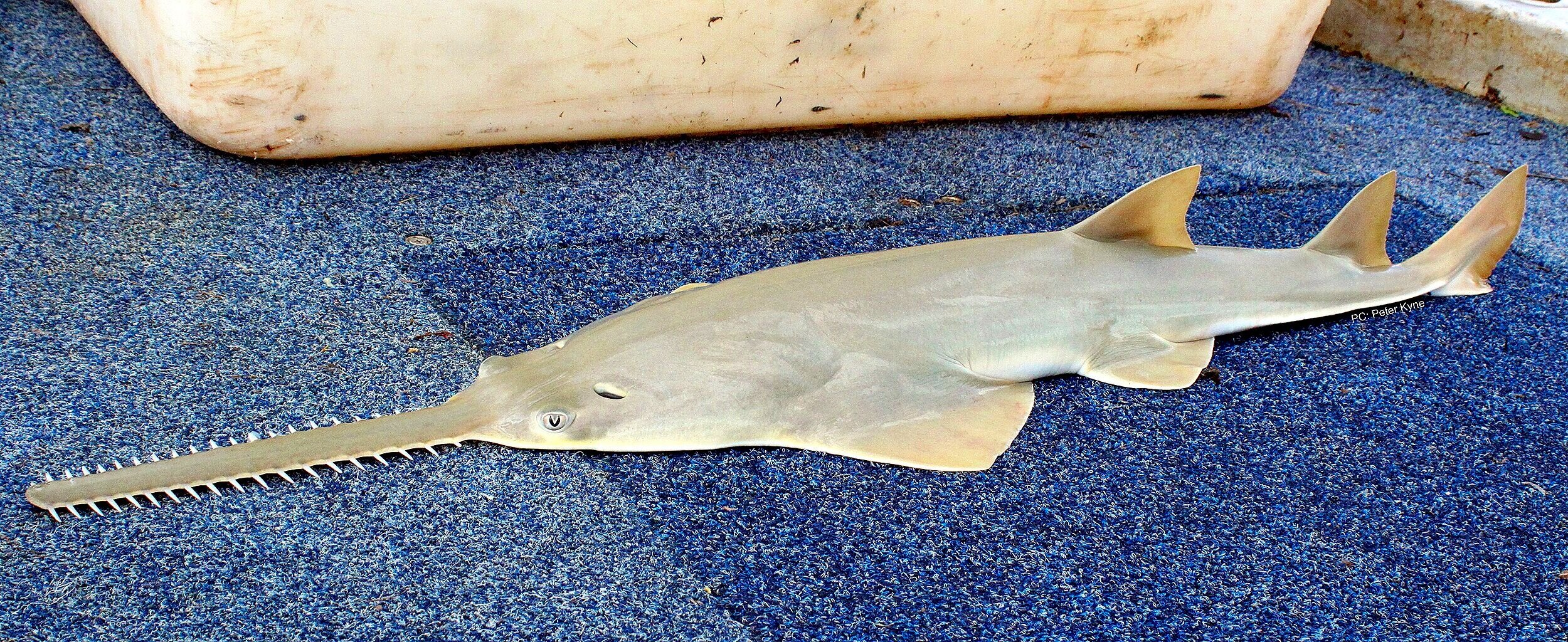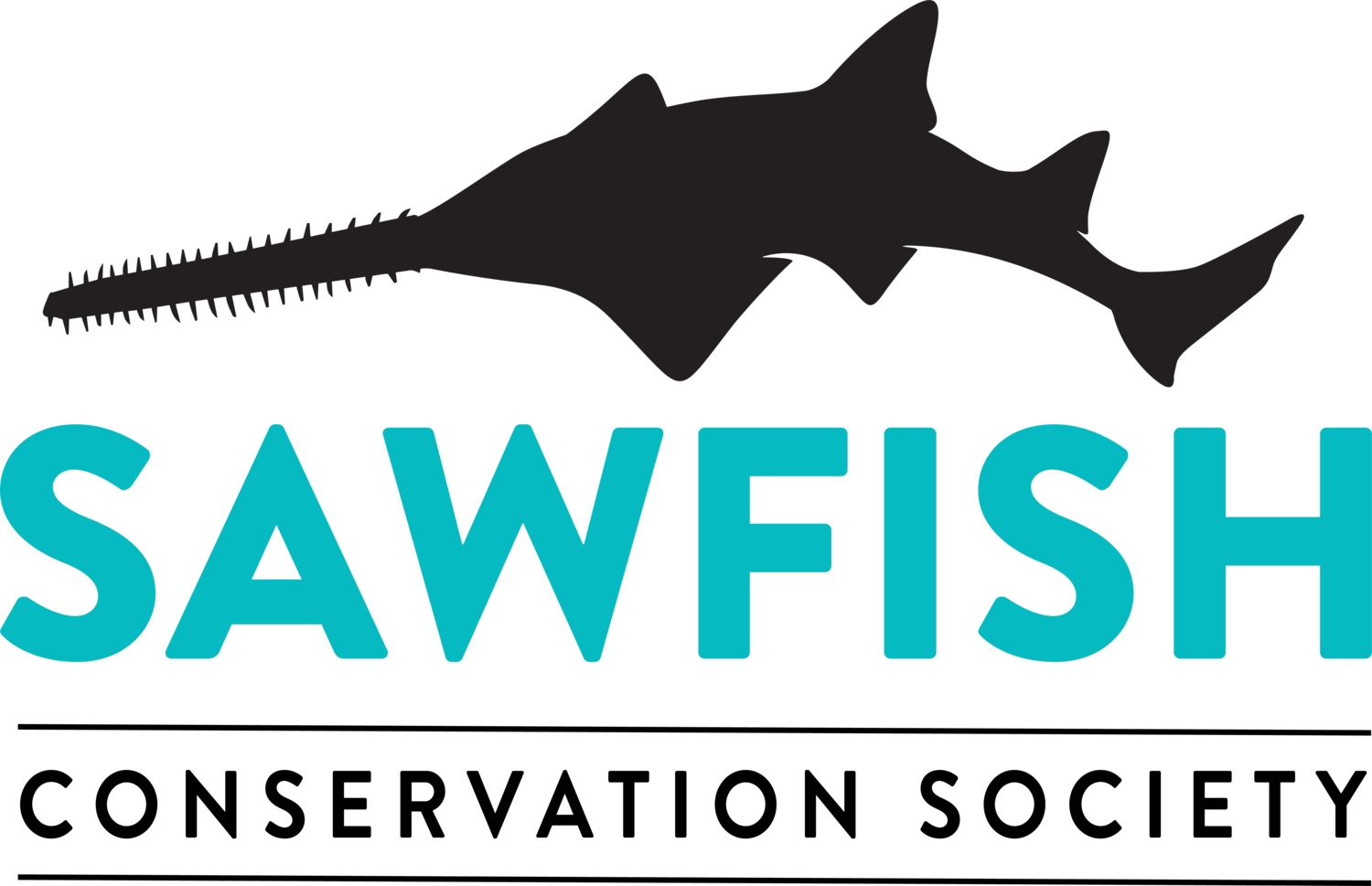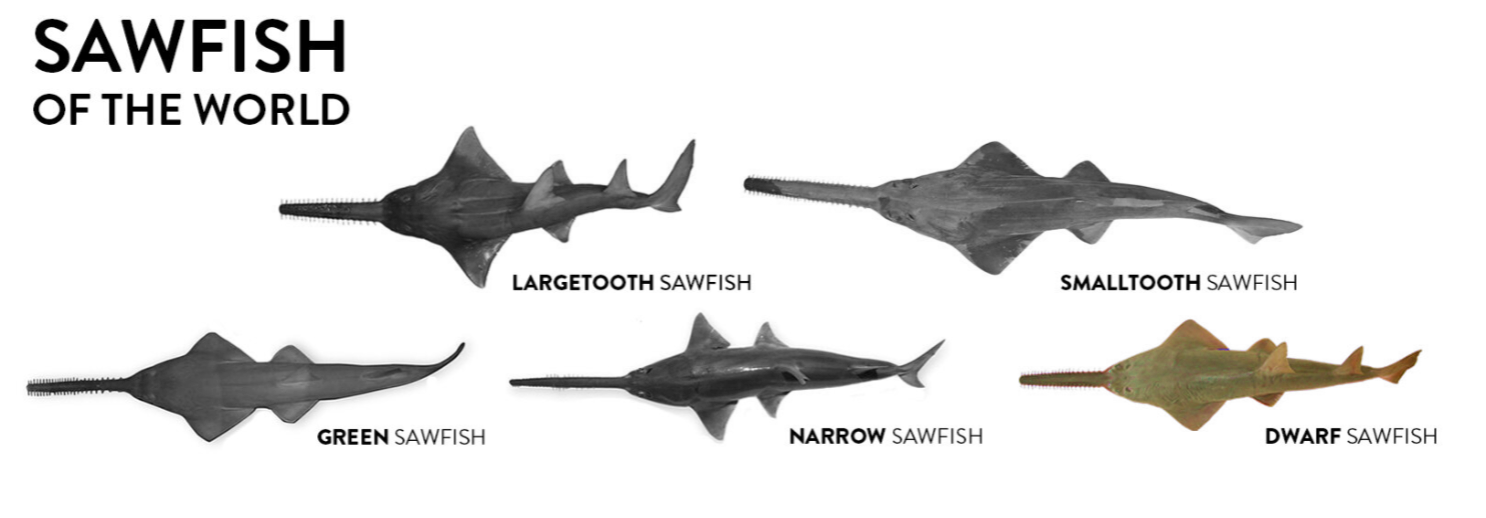
DWARF SAWFISH Pristis clavata
IUCN status: ENDANGERED
The dwarf sawfish (Pristis clavata) is one of the smallest species of sawfish and grows to a maximum total length of around 400 cm (13.1 feet). The dwarf sawfish lives in shallow nearshore estuaries, creeks and bays in the Indo-West Pacific (most commonly in Australia). The dwarf sawfish can be best identified by: a small to non-apparent lower caudal (i.e. tail) fin, the start of its first dorsal (i.e. top) fin inline with that of its pelvic fins and evenly spaced rostral teeth. The dwarf sawfish has 18-27 rostral teeth per side. See below for detailed information.
SIZE: 80 to 300+ cm/2.6 to 9.8+ feet total length
DISTRIBUTION: Indo-West Pacific
IDENTIFICATION: Start of first dorsal (top) fin inline or just behind start of pelvic (lower, bottom) fins, no noticeable lower lobe on caudal (tail) fin, with a rostrum with evenly spaced rostral teeth.
DWARF SAWFISH DESCRIPTION
Size: Pupped at 65-81 cm total length (TL) (Peverell 2008, Last and Stevens 2009). Estimated to attain a maximum total length of 508 cm (Peverell 2005). Captured at sizes up to 318 cm total length (Peverell 2008, Stevens et al. 2008).
Fin position/markings: Narrow pectoral fin width with a long base (Compagno and Last 1999, Last and Stevens 2009). Lower lobe of caudal fin small to non-existent (Ishihara et al. 1991). Origin of first dorsal fin inline or just posterior with that of the pelvic fin (Ishihara et al. 1991, Compagno and Last 1999). Lacks an anal fin. No discernible markings on fins.
Rostral morphology and meristics: Relatively wide rostrum, with standard rostrum width ranging from 16-22% of standard rostrum length (SRL) (Whitty et al. in press). Standard rostrum length and total rostrum length were reported to range from 15-22% (SRL = 0.5592TL0.8749) and 16-26% of total length (Ishihara et al. 1991a, Thorburn et al. 2008, Whitty et al. in press).
Pristis clavata has 18-27 rostral teeth per side (Compagno and Last 1999, Faria et al. 2012, Whitty et al. in press), although counts can vary between 0-2 from one side to the other (Whitty et al. in press). No significant difference in rostral tooth counts between male and female P. clavata (Thorburn et al. 2008, Whitty et al. in press). Posterior groove on rostral teeth partial in juveniles but extends further in adults (Thorburn et al. 2007, Whitty et al. in press). Most distal rostral tooth gap is 25-70% that of the most proximal rostral tooth gap (Compagno and Last 1999, Whitty et al. 2013).
Dermal denticles: Monocuspidate denticles set closely together on dorsal and ventral surfaces and within the buccopharyngeal cavity (Deynat 2005). No furrows or ridges on anterior edges of dermal denticles (Deynat 2005).
Vertebral Count: Undocumented
DWARF SAWFISH HABITAT
Distribution: Reported to occur in the eastern Indo-West Pacific (Australia through to Oman) (Faria et al. 2012). Most commonly reported in Australia (Ishihara et al. 1991a, Peverell 2005, Thorburn et al. 2008, Last and Stevens 2009, Morgan et al. 2010). Map available at www.iucnredlist.org.
Habitat: Inhabits shallow, turbid and tidally influenced river mouths, creeks and estuaries (Ishihara et al. 1991a, Peverell 2005, Stevens et al. 2008,Thorburn et al. 2008). Moves into upper estuaries during the late dry season as salinity increases. Moves into deeper water during outgoing tides, to mangrove creeks during high tides and rests in between tides (Stevens et al. 2008). Pristis clavata has been observed to inhabit waters with a salinity of 1-41.1 ppt and temperature of 25-32 C (Thorburn et al. 2007).
DWARF SAWFISH LIFE HISTORY
Age and growth: Pristis clavata were reported to be at age 1+ at 90-100 cm, 2+ at 110-120 cm, 3+ at 160-175 cm, 4+ at 225 cm and 5+ at 244 cm total length (Peverell 2008,Thorburn et al. 2008). K-value of 0.08 per year (Linfin = 508 cm, t0 = -2.09) (Peverell 2008). Asymptotic growth was estimated to be reached at 34 years (389 cm total length) (Peverell 2008).
Reproduction: Aplacental viviparity (lecithotropic nutrition) (Stevens et al. 2005, Last and Stevens 2009). Litter size has not been documented.
Maturity: Reaches maturity around 255-260 cm TL (Peverell 2005, Thorburn et al. 2008, Last and Stevens 2009).
DWARF SAWFISH DIET
Pristis clavata in Western Australia were found to have consumed prawn, popeye mullet (Rhinomugil nasutus), unidentified teleost and detrital matter (Thorburn et al. 2008). Gut contents of P. clavata captured in Queensland included banana prawns (Penaeus merguiensis), tiger prawns (Penaeus esculentus), beach salmon (Leptobrama muelleri), Mugilidae (e.g. mullet), Clupeidae (e.g. herring) and scale croaker (Nibea squamosa) (Peverell 2008).
DWARF SAWFISH POPULATION GENETICS
The levels of genetic diversity (mtDNA) in P. clavata in Australian waters are generally moderate to low, however, levels of diversity are severely reduced in the Gulf of Carpentaria (Phillips et al. 2011). This suggests that population(s) in the Gulf of Carpentaria may have undergone a greater decline in abundance (see Phillips et al. 2011) or was more recently founded than those elsewhere in Australia (Phillips 2012). Regardless, much of the diversity found in P. clavata is present as rare haplotypes, which are at risk of being lost via genetic drift and further declines in abundance (Phillips et al. 2011). Assemblages of P. clavata on the western and northern coasts of Australia and the Gulf of Carpentaria are distinct genetic stocks, with negligible gene flow of both males and females between geographic regions, increasing the risk of localized extirpation (Phillips et al. 2011; Phillips 2012).
DWARF SAWFISH STATUS
Population estimates are unknown. However, evidence suggests a decline in the numbers and range of Pristis spp. in Australia (Stevens et al. 2005, White and Kyne 2010).
Pristis clavata is listed as Endangered on the IUCN Red List (IUCN 2013). In Australia, P. clavata is listed as Vulnerable on the EPBC Act and is protected in state waters in Western Australia, Queensland and in the Northern Territory. Pristis clavata is listed under Schedule I on the Wildlife Protection Act in India.

